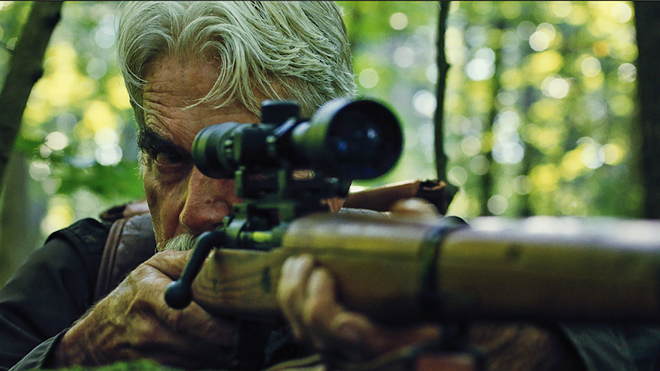
Sam Elliott is a national treasure.
In a career that’s spanned more than 50 years, and included such memorable films as Mask, Road House, Tombstone and, most recently, A Star Is Born (which garnered his first-ever Oscar nomination), Elliott’s cosmic cool, iconic mustache and resonating voice have left an indelible mark.
So, it makes sense that writer-director Robert D. Krzykowski would want Elliott to topline his feature-length debut, a curious meditation on aging, machismo, love and all the little-known adventures that make up the merit of a man’s life.
If only The Man Who Killed Hitler and Then The Bigfoot was a better vehicle to showcase Elliott’s gifts as an actor. As is, the film falls somewhere between drive-in pulp and melodrama, hobbled by a surprising lack of action and burdened by Krzykowski’s obvious, overly ambitious desire to create transcendent art.
Elliott plays Calvin Barr as an old man, his body no longer indestructible and his spirit sapped by regret and a dearth of meaning. When we first meet Barr, he’s sitting on a bar stool not unlike The Stranger, his poetic cowboy narrator in The Big Lebowski.
He’s in a reflective mood, thinking back to his younger days when he accepted a suicide mission to infiltrate the Third Reich and kill Adolf Hitler.
The Man Who Killed… bounces back and forth in time, highlighting the life lessons that Barr has learned, from a too-involved mystic shave by a spiritual shaman to a tender moment with his brother Ed (Larry Miller), where he confesses his crimes of war.
“It feels weird to kill a man,” Barr says, “even if he had it coming.”
For a film that prominently promises the death of history’s most reviled villain, The Man Who Killed… surprisingly spends little time in Germany, and meanders way too much between subplots involving a serial killer in Canada (that would be The Bigfoot) and a covert government agent named Flag Pin (Ron Livingston), who tracks Barr down to enlist his help in killing the furry beast.
Flag Pin tells Barr that he grew up hearing stories from his grandfather of the mythical war hero who saved humanity, and now that hero is needed once again. The Bigfoot, it turns out, is a harbinger of the apocalypse, a carrier of the “nightmare plague,” but Barr’s special DNA means he’s immune. Flag Pin implies that Barr is the last of a breed of super soldiers, suggesting a larger mythology that the film inexplicably ignores.
Barr tells Flag Pin that he’s not the comic book hero everyone believes and that history can’t be trusted because both the U.S. government and the Nazis lied. He says his successful assassination was for naught as the Germans hired fake Hitler’s to fool the world and further the war until the last committed suicide in a bunker, a cowardly actor finally cornered with no way to perpetuate the lie.
That’s some deep shit, and the kind of imaginative world-building that could easily form the foundation for an instant cult classic, but the third act steers clear of such narrative and emotional depth, instead plunging viewers deep into Barr’s hunt for The Bigfoot, which ends with a surprisingly pedestrian final fight.
I wanted to love The Man Who Killed Hitler and Then The Bigfoot, but once the credits rolled, I found myself oddly, coldly unaffected, my own spirit dulled by the tantalizing subplots left unfinished and the true essence of its titular Man sadly left unexplored.
John W. Allman has spent more than 25 years as a professional journalist and writer, but he’s loved movies his entire life. Good movies, awful movies, movies that are so gloriously bad you can’t help but champion them. Since 2009, he has cultivated a review column and now a website dedicated to the genre films that often get overlooked and interviews with cult cinema favorites like George A. Romero, Bruce Campbell and Dee Wallace. Contact him at bloodviolenceandbabes.com, on Facebook or on Twitter.

